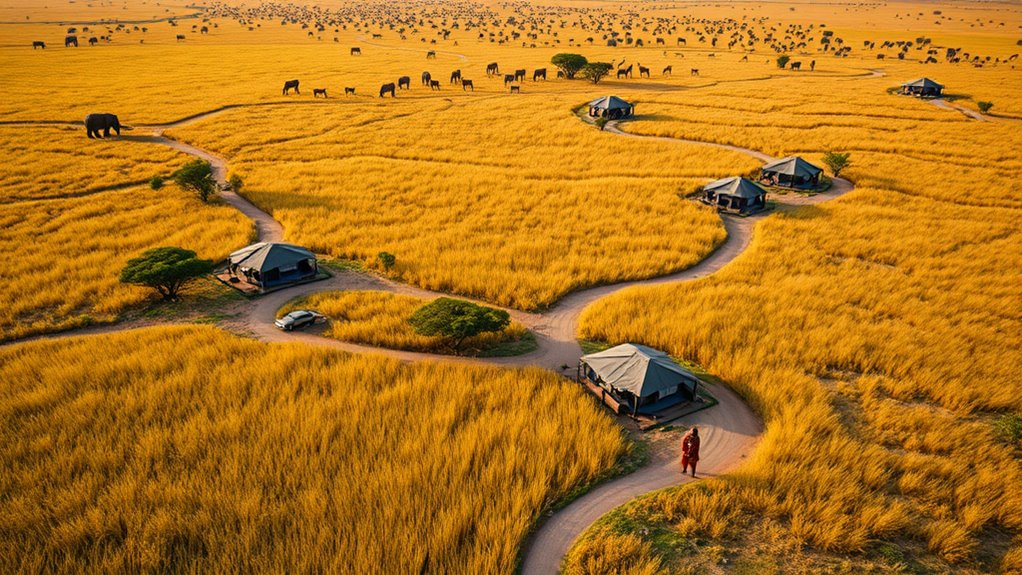Kenya’s community-owned conservancies empower local communities to lead wildlife protection while benefiting economically through eco-tourism, traditional practices, and sustainable resource management. These conservancies originate from indigenous land management and have evolved with modern conservation strategies, combining technology and community engagement. They’ve achieved success in preserving biodiversity and boosting local livelihoods through revenue sharing and cultural activities. To discover how these initiatives continue to grow and impact Kenya’s wildlife and communities, explore more about their inspiring journeys.
Key Takeaways
- Kenya’s community-owned conservancies empower local communities to manage wildlife sustainably, ensuring economic benefits and biodiversity conservation.
- Traditional knowledge and indigenous practices are integrated into modern conservation strategies within these conservancies.
- Revenue from eco-tourism and sustainable resource use supports community development and wildlife protection efforts.
- Community leadership and active youth involvement foster stewardship, fostering ecological resilience and social empowerment.
- Technologies like GPS and drone monitoring enhance wildlife tracking and conservation effectiveness in these conservancies.
The Origins and Evolution of Community Conservancies in Kenya

Kenya’s community conservancies have their roots in traditional Maasai land management practices, which emphasized coexistence with wildlife and sustainable resource use. Over time, these practices evolved into formal conservation initiatives, blending indigenous storytelling to pass down ecological knowledge across generations. This cultural approach fosters a deep connection to the land, inspiring eco-friendly innovations that protect both people and wildlife. By integrating traditional wisdom with modern conservation strategies, communities create sustainable models that benefit local livelihoods and preserve biodiversity. These origins highlight how indigenous storytelling and eco-conscious innovations shape Kenya’s community conservancies, ensuring that conservation efforts remain rooted in cultural values while adapting to contemporary environmental challenges. Wisdom from ancient Egyptian teachings underscores the importance of harmony and balance, which continue to inspire sustainable practices today. This history underscores the importance of respecting local traditions in building resilient, community-driven conservation systems.
How Local Communities Drive Conservation Efforts

You play a crucial role in driving conservation efforts through local leadership and decision-making. Revenue sharing models guarantee communities benefit directly, motivating ongoing protection of natural resources. By integrating traditional knowledge, communities create sustainable solutions that respect cultural practices and preserve biodiversity. Implementing AI security measures can further enhance the protection of these valuable ecosystems by monitoring threats in real-time.
Community Leadership Roles
Local communities play a vital role in driving conservation efforts within Kenya’s community-owned conservancies. Your active participation shapes successful management and sustainable practices. Community empowerment is key; when you have a voice in decision-making, you’re more committed to protecting your natural resources. Leadership development programs help you build skills necessary to lead conservation initiatives, from establishing patrols to promoting eco-friendly practices. As a community leader, you motivate others, organize activities, and guarantee that conservation goals align with local needs. Your leadership fosters a sense of ownership and responsibility, encouraging everyone to contribute to the conservancy’s success. Ultimately, your role as a community leader not only preserves biodiversity but also enhances local livelihoods, creating a sustainable future rooted in collective effort.
Revenue Sharing Models
How do communities guarantee that their conservation efforts are sustainable and beneficial? By establishing effective revenue sharing models that prioritize community engagement and diverse funding mechanisms. These models ensure that locals receive direct benefits, motivating ongoing conservation. You’ll find successful conservancies use:
- Profit-sharing from tourism, ensuring communities benefit financially
- Access to grants and government funding, bolstering financial stability
- Community-owned businesses that generate sustainable income
These approaches empower locals to take ownership of conservation projects, reinforcing their commitment. Transparent revenue sharing fosters trust and accountability, encouraging continuous participation. By integrating various funding mechanisms, communities can adapt and thrive, making conservation both practical and profitable. Incorporating performance-based incentives can further motivate conservation efforts and improve overall success. This synergy between community engagement and innovative funding secures long-term success for Kenya’s conservancies.
Traditional Knowledge Integration
Traditional knowledge plays a vital role in driving conservation efforts by providing communities with time-tested insights into local ecosystems and wildlife behavior. You can see how indigenous practices and ancestral knowledge shape sustainable resource management, guaranteeing ecosystems remain balanced. You might notice that this approach not only enhances biodiversity protection but also empowers communities to take ownership of conservation initiatives. Respecting and incorporating indigenous practices ensures that conservation efforts are deeply rooted in local realities, making them more sustainable and impactful over the long term. Additionally, color accuracy in traditional methods helps communities accurately interpret environmental changes and respond effectively.
Key Success Stories and Case Studies

Kenya’s community-owned conservancies have achieved remarkable success by empowering local communities to protect their natural resources while generating sustainable income. These success stories highlight how community empowerment boosts ecological resilience, ensuring long-term conservation. For example, the Ol Pejeta Conservancy transformed local engagement into a thriving wildlife sanctuary, balancing conservation and livelihood needs. Another case is the Maasai Mara Conservancies, where community-led management has increased wildlife populations and improved local wellbeing. Additionally, the Laikipia Plateau project demonstrates how integrating traditional knowledge with modern conservation methods enhances ecological resilience. These examples prove that when communities are actively involved, they become stewards of their environment, securing both biodiversity and sustainable development.
Community-owned conservancies in Kenya foster sustainable conservation and local well-being through community engagement and traditional knowledge.
- Community-driven conservation initiatives lead to healthier ecosystems
- Local benefits motivate continued community participation
- Traditional knowledge enhances ecological resilience
- Careful management of tanning sessions ensures skin health and safety.
The Role of Eco-Tourism in Supporting Conservancies

Eco-tourism plays a crucial role in supporting conservancies by providing community benefits and incentives that encourage wildlife protection. It also generates funding for conservation efforts and promotes sustainable tourism practices. By participating in eco-tourism, you help guarantee the long-term health of Kenya’s wildlife and local communities. Additionally, sustainable practices such as implementing advanced technology in conservation efforts can further enhance the effectiveness and efficiency of protecting natural resources.
Community Benefits and Incentives
How does eco-tourism serve as an essential incentive for community-owned conservancies? It boosts community engagement by providing tangible benefits, motivating locals to protect wildlife and land. Eco-tourism creates incentive structures that directly reward communities, encouraging sustainable practices. When visitors come, your community can earn income, creating jobs and improving local infrastructure. This revenue strengthens conservation efforts and fosters pride in your environment. Eco-tourism also promotes cultural exchange, deepening residents’ connection to their heritage. By aligning economic benefits with conservation goals, eco-tourism ensures communities see tangible value in protecting their natural resources. Additionally, understanding the importance of conservation helps communities recognize the long-term benefits of protecting biodiversity and ecosystems.
Wildlife Conservation Funding
Have you ever wondered how eco-tourism helps fund wildlife conservation efforts? It’s an essential funding mechanism that supports conservancies through entrance fees, guided tours, and lodges. These revenue streams sustain local communities and protect wildlife habitats. Donor partnerships also play a fundamental role, providing grants and technical support to strengthen conservation initiatives. Incorporating tea accessories into eco-tourism programs can also enhance visitor experience and promote sustainable practices.
Sustainable Tourism Practices
Sustainable tourism practices make certain that the benefits of eco-tourism are balanced with the needs of local communities and wildlife. By choosing responsible travel options, you help guarantee that conservation efforts thrive and communities prosper. Eco-friendly accommodations, such as lodges powered by renewable energy, minimize environmental impact. Participating in community-led tours supports local livelihoods and fosters cultural exchange. Additionally, respecting wildlife and staying on designated paths reduces habitat disturbance. Your conscious choices directly contribute to the long-term health of Kenya’s conservancies. Engaging in responsible travel not only enriches your experience but also sustains the natural and cultural treasures for future generations. By embracing these practices, you become an active part of conservation efforts and community development through eco-tourism.
Economic Benefits for Local Populations

Community-owned conservancies in Kenya generate significant economic benefits for local populations by providing new sources of income and employment. You can participate in cultural rituals that attract tourists, boosting local engagement and pride. Additionally, the sale of local crafts, like beadwork and carvings, offers sustainable revenue streams. These activities empower communities to manage resources and retain profits locally. Furthermore, implementing AI-driven solutions can optimize resource management and improve economic outcomes in these conservancies.
| Cultural Rituals | Local Crafts |
|---|---|
| Attract tourists | Generate income |
| Preserve traditions | Promote craftsmanship |
| Foster community pride | Support local markets |
Challenges Faced by Community-Owned Conservation Initiatives

While community-owned conservancies bring notable economic benefits, they also face a range of challenges that can hinder their success. Land rights issues often create conflicts, making it difficult to establish clear boundaries and management authority. Limited environmental education can reduce community engagement and awareness of conservation importance. Additionally, securing sustainable funding remains a constant obstacle, threatening long-term viability.
- Disputes over land rights can lead to conflicts and undermine trust among community members
- Insufficient environmental education hampers local support and effective conservation practices
- Limited access to funding affects infrastructure, staffing, and conservation efforts
Addressing these challenges requires strengthening land rights, boosting environmental education, and finding innovative financing solutions to sustain conservation initiatives in the long run.
Policy Frameworks and Government Support

Kenya has established laws that encourage the development of community conservancies, providing a legal foundation for their growth. You’ll see the government also offers funding programs to support these initiatives financially. Understanding how these policies and resources work together can reveal their impact on conserving wildlife and empowering local communities.
Legislation Promoting Conservancies
Government policies and legal frameworks play a pivotal role in fostering the growth of conservancies by providing clear guidelines, protections, and incentives. These legal frameworks support policy development that enables communities to establish and manage conservancies effectively. When legislation is well-designed, it encourages local participation and ensures sustainable resource use.
- Simplifies registration processes for community conservancies
- Offers legal protections for land rights and resource access
- Provides incentives like tax benefits and grants to boost conservation efforts
Government Funding Initiatives
Government funding initiatives play an essential role in strengthening community-owned conservancies by providing the financial support necessary for their development and sustainability. You can benefit from targeted policies that encourage private partnerships, which bring in investment and expertise to conserve wildlife and promote eco-tourism. Additionally, international aid plays a crucial part by funding conservation projects and capacity-building efforts. These initiatives help bridge funding gaps, ensuring conservancies remain operational and resilient amid economic challenges. The government’s support often includes grants, subsidies, and strategic programs designed to empower local communities. By leveraging both private partnerships and international aid, Kenya’s conservancies can expand their impact, protect biodiversity, and generate sustainable income for local residents. This all-encompassing approach fosters long-term conservation success.
Cultural Values and Traditional Practices in Conservation

Traditional practices and cultural values play a vital role in shaping conservation efforts within Kenya’s community-owned conservancies. These customs foster respect for the environment and wildlife, ensuring sustainable coexistence. You’ll find that cultural rituals and traditional ceremonies often include conservation themes, reinforcing community bonds and environmental stewardship. For example:
- Using sacred sites and rituals to protect key habitats
- Incorporating traditional ceremonies to honor wildlife and nature
- Engaging community elders to uphold conservation-related cultural practices
The Impact on Wildlife Preservation and Biodiversity

Community-owned conservancies in Kenya have a significant positive impact on wildlife preservation and biodiversity. By fostering community engagement, local people become active stewards of their natural resources, which leads to better protection of species and habitats. Ecological research conducted within these conservancies provides valuable data, helping you understand wildlife trends and threats. This knowledge enables you to develop targeted conservation strategies that improve biodiversity outcomes. Additionally, community involvement ensures that conservation efforts align with local needs and traditional practices, strengthening support for wildlife protection. As a result, these conservancies not only safeguard endangered species but also promote healthier ecosystems. Your participation in community-led initiatives helps sustain Kenya’s rich biodiversity for future generations.
Future Prospects and Opportunities for Growth

Building on the success of community-owned conservancies in safeguarding Kenya’s wildlife, there are promising opportunities to expand their reach and impact. You can leverage innovative technologies like GPS tracking and drone surveillance to enhance conservation efforts and monitor wildlife more effectively. Engaging youth is essential; involving young people in conservation projects fosters a new generation of stewards and brings fresh ideas. Additionally, developing eco-tourism initiatives can generate sustainable income and create jobs within local communities.
Community conservancies in Kenya can grow through technology, youth engagement, and eco-tourism for sustainable wildlife protection.
- Implementing innovative technologies to improve wildlife monitoring
- Promoting youth engagement through education and participation
- Expanding eco-tourism to boost local economies and conservation efforts
Frequently Asked Questions
How Do Community Conservancies Impact Local Education and Healthcare Services?
Community conservancies boost local education and healthcare by fostering eco-tourism benefits and encouraging community engagement. You see, as eco-tourism grows, funds are generated that support schools and clinics. When locals are involved, they take pride in conserving their environment, which leads to better resource management. This active engagement improves access to quality education and healthcare services, creating a cycle of community development that benefits everyone in the area.
What Are the Long-Term Sustainability Plans for Community Conservancies?
Think of sustainability plans as a sturdy tree that needs strong roots. You’ll want to focus on diverse funding strategies, like eco-tourism, grants, and community initiatives, to keep it thriving. Governance models must be transparent and inclusive, empowering locals to make decisions. By nurturing these areas, your conservancies can grow resilient, ensuring long-term protection of resources while benefiting communities well into the future.
How Do Conservancies Address Human-Wildlife Conflicts?
You see, conservancies address human-wildlife conflicts by creating wildlife corridors that connect habitats, reducing animal encounters with people. These corridors help animals access food and water, minimizing crop damage and property loss. Additionally, eco-tourism benefits encourage local communities to protect wildlife, fostering coexistence. By involving communities in conservation, conservancies promote sustainable practices that decrease conflicts, ensuring both human safety and wildlife preservation for the long term.
What Role Do Women and Youth Play in Conservancy Management?
Imagine the power you hold in shaping the future—women and youth are key players in conservancy management. Their roles foster gender inclusion and inspire youth leadership, creating vibrant, sustainable communities. By actively participating, they help drive conservation efforts, ensuring diverse perspectives guide decisions. Their involvement isn’t just essential; it’s transformative, enabling new opportunities for shared stewardship and resilience. Are you ready to champion this change?
How Can Conservancies Adapt to Climate Change Challenges?
You can help conservancies adapt to climate change by promoting sustainable tourism practices that reduce environmental impact. Implementing renewable energy solutions, like solar power, decreases reliance on fossil fuels and boosts resilience. Supporting community-led initiatives ensures local voices shape strategies, making conservation efforts more effective. By embracing these approaches, conservancies can better withstand climate challenges, protect biodiversity, and sustain their economic and ecological benefits for future generations.
Conclusion
By now, you can see that Kenya’s community conservancies are truly the backbone of wildlife preservation and local development. When communities take the lead, conservation efforts flourish, and benefits multiply. It’s a win-win situation that proves you can have your cake and eat it too—protecting nature while uplifting livelihoods. With continued support and innovative ideas, these conservancies will keep growing stronger, ensuring Kenya’s rich biodiversity remains a treasure for generations to come.









